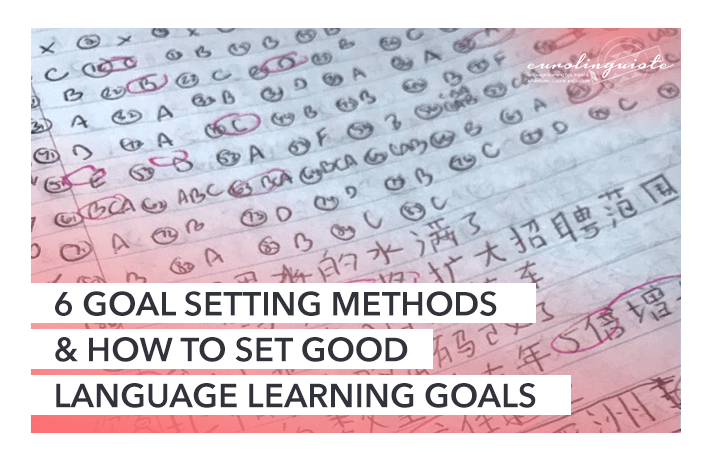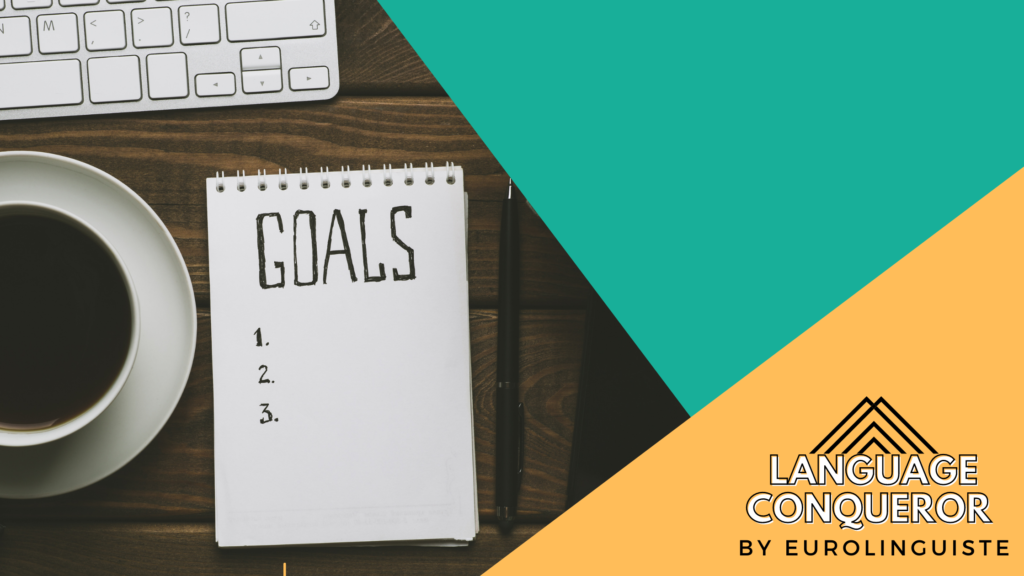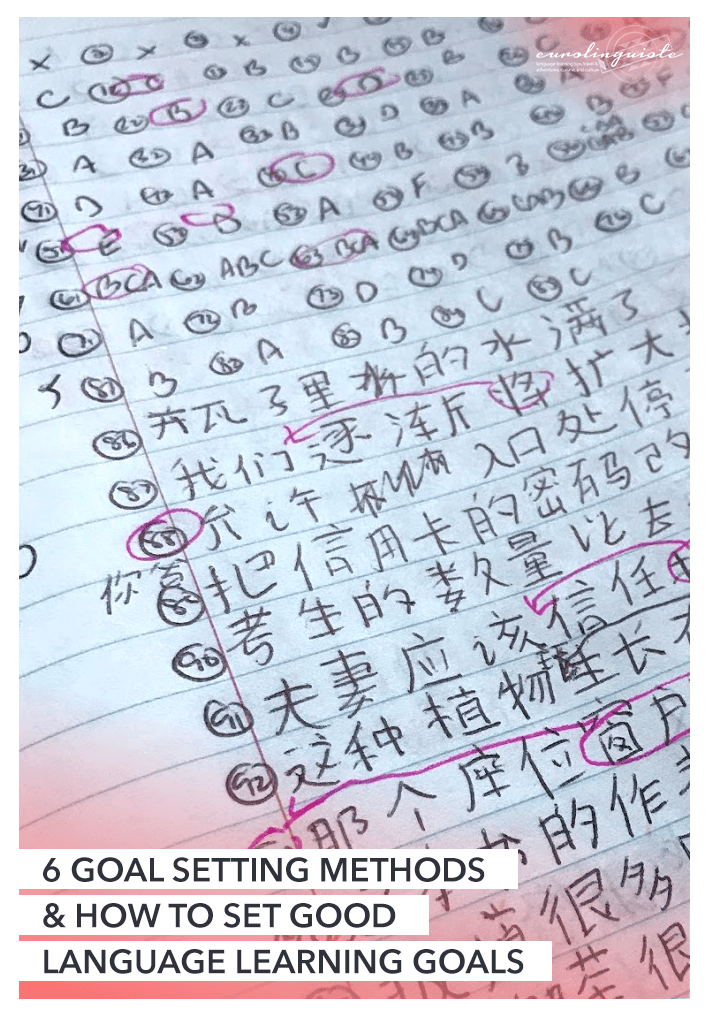6 Goal Setting Methods & The Ultimate Guide to Setting Good Language Learning Goals

My name is Shannon Kennedy and I'm the language lover,…
The new year is around the corner and many of us are setting our New Year’s resolutions.
Since you’re here you’ve likely set goals related to language learning. But are they good goals?
Wait… what?
No, don’t worry. I’m not judging you.
Rather, I’m here to help you make sure you’re setting good language learning goals.
What does a good goal look like?
For me, a good goal is something that’s specific, has a deadline, and a system for me to work towards it.
Let me share my goal for the new year with you as an example.
I want to learn 2,500 words in Norwegian within 3 months by using my go-to vocabulary app.
I have a specific goal: 2,500 words in Norwegian. I have a deadline: 3 months. And I have a system: my go-to vocabulary app.
How to Set Good Language Learning Goals
A few years ago, if you had asked me what my language learning goal was, it would have probably been something like “learn to speak Chinese fluently!”
But this goal is problematic for a variety of reasons.
First, it’s not specific. What does “fluently” mean? Does it mean at a native-like level? Does it mean perfectly? Does it mean being conversational? There are many different kinds of “fluent”. Which one was I aiming for?
Second, there wasn’t a deadline. When was I hoping to be fluent? Was there a set date? Or was it just something I generally wanted to achieve in my life?
And finally, I didn’t have a system. What exactly was I going to do to reach fluency?
I didn’t have the answer to those questions. So instead, I set another goal. Pass the HSK 4 exam after studying for 1 year. Now that’s a specific goal with a deadline. My system? Taking weekly lessons and completing practice tests. Did I succeed? You bet.
If your goals look a lot like my initial goal, don’t worry. I’m here to help you out and create goals more like my altered goal.
Here are 6 goal setting methods and systems to help you achieve your language learning goals in the new year.
SMART Goals
If you’re familiar with any goal setting system, it’s likely SMART goals. SMART stands for:
- Specific: you have a specific, targeted goal (like learn 50 words)
- Measurable: you have steps that get you to your goal (learn 5 words a day for 10 days)
- Attainable: your goal is realistic (learn 50 words in 10 days [learning 200 words in 10 days is likely not attainable])
- Relevant: your goal is relevant to you (for example, learning 50 words in the language you’re studying is more relevant than learning 50 words in a random language you don’t have any long term plans with)
- Time-related: you have deadlines (again in our example, 10 days)
Here are a few of SMART language learning goals:
- Learn 50 words in Norwegian in 10 days.
- Do 15 minutes of Persian listening every day for 1 month.
- Have one 1-hour lesson in Croatian every week.
OKRs
Familiar with the expression “shoot for the moon, even if you miss you’ll land among the stars”? Those are OKR goals. An OKR goal is where you go big or go home and it stands of “objectives and key results”. And even if you don’t reach your OKR goal, you will still likely get farther in your learning than you would if you set a more conservative goal.
Here are examples of OKR language learning goals:
- Have a 30-minute lesson in Russian every day for a month. (You’ll likely miss days, but still have far more Russian lessons than you would have otherwise.)
- Complete 1 language learning course book every single month. (Again, you might not finish an entire course book every month, but you’ll likely work through a lot more than you would with a more conservative goal.)
4DX
4DX, The 4 Disciplines of Execution, is a goal-tracking framework developed by Stephen R. Covey and Chris McChesney. This method is similar to OKRs, but these bigger goals are things you intend to reach (whereas OKRs focus on overperformance).
The disciplines that make up 4DX are:
- Focus on wildly important goals (WIGs): in other words, focus on the most important things
- Act on lead measures: put energy into the work that will yield the greatest results (the 80/20 rule)
- Keep a compelling scoreboard to track progress: a little friendly competition does wonders
- Create accountability: when you have encouragement and community, you have greater chances of success
Speaking of accountability and community, now is the perfect time for me to take a quick commercial break to announce something new and exciting!
Recently, I put together a program called Language Conqueror.
Each month, we release a new language Quest and this coming month’s Quest focus is all about… goal setting! We go in-depth and provide loads of information on how to set good language learning goals and how to build systems to help you reach them. You’ll also get access to our course community where you can chat with other language learners like yourself.
You can learn more about Language Conqueror and join us here.

Now back to 4DX goals.
Here is an example of a 4DX goal:
If you are aiming to learn conversational Japanese, you would most need to focus on speaking and listening comprehension. So you should spend 80% of your study time working on improving your speaking and listening skills. By joining a community of other learners, you can compare how much time you spend working on these skills and even have a bit of friendly competition with them to rack up the most time.
V2MOM
Another method of goal setting is called V2MOM and it stands for:
- Vision: what you want to accomplish
- Values: the principles that guide you
- Methods: the steps and actions you take
- Obstacles: any challenges or issues you may need to overcome
- Measures: the goal’s minimum achievement
An example of a V2MOM goal for language learning is:
You want to learn conversational Hungarian (vision) without spending any money on resources because you’re working to keep a tight budget (values). You’ll find exchange partners and other free resources to study, getting creative in your search for tools because finding high-quality, free resources is challenging. You’ll measure “conversational” as being able to keep an entire 1-hour exchange in the language at the end of a year.
Onion Goals
My good friend Lindsay of Lindsay Does Languages introduced me to a goal setting system called “Onion Goals”. This is where you imagine goals and systems as the layers of an onion. At the center, you have your goal. And each layer you peel is a step you need to take to get to that goal.
You ask yourself how at each stage until you get to a step you can take each day.
Here’s an example of an onion goal in language learning:
I want to learn 50 words. How? By studying them with my favorite app. How? By studying five new words a day. How? By adding the new words that come up in my lessons to the app. How? By asking my teacher to add words I don’t know or understand to the chat during our lessons.
Ladder Goals
Another goal setting method I learned from Lindsay is “Ladder Goals”. This is more about the “what” than the “how”.
So you take a goal and identify what small goals, targets, and tasks need to be achieved to make that top goal happen. You work backward, or down the rungs of a ladder.
So let’s return to the example of learning 50 words. What do you need to do this?
- You’ll need to curate your word list
- Get that list into Memrise
- Study the words
- And review them so they stay in your memory
So there you have it. Six ways you can set goals.
But goal setting isn’t always enough.
Why Goal Setting Isn’t Enough When You’re Learning a Language
When it comes to learning languages, I think that setting aside time to set goals and then later re-evaluate those goals and your progress towards them is crucial to one’s success.
Each month, I do just that, but I realized that my review and planning was really quite short-term. I hadn’t really looked any farther ahead or back than a month at a time.
So I decided to take some time to sit down and look at my language learning progress on a larger scale.
I went through old blog posts and notes, reviewing the past year or two. I found that I was quite surprised at how much my language learning methods have changed.
To be honest, I’m not so sure why I was surprised by just how much my methods of changed. Somewhere in the back of my mind I was vaguely aware of the changes, I had even mentioned them in various interviews and posts. But somehow, the totality of it managed to escape me.
I started learning languages “seriously” about four or five years ago (goodness, where does the time go?), but when I first set out, I really didn’t know what I was doing. As I mentioned in other posts, my process included running out to the local bookstore, buying any books I didn’t already have, only to return home and let them collect dust on my shelves.
Needless to say, this method really didn’t work for me.
And I’d even go as far as saying, that I don’t imagine this method working for anyone.
It wasn’t until I realized that being an independent language learner didn’t mean that I had to go about learning a language all by myself that I started to get my process sorted to the point that I could develop a system that worked for me.
How Getting to Know the Online Language Learning Community Changed My Learning for the Better
As I began to discover other language learners online, realizing that their learning was conducted utilizing methods so much more effective than my own, I started to look at what I was doing quite differently.
Up until that point, I felt that language learning was something that one did with a textbook in a classroom environment (and I was trying to create this experience by doing activities out of one of my old textbooks, having it corrected by native speakers as though it was my “homework”).
But as I started to look around online, I discovered a whole new world of language learning methods.
There were (and are) apps, videos, courses, books, games, and conversation exchange platforms the went far beyond learning to buy plane tickets or book hotel reservations. Languages weren’t just for getting around for travel, they are a way to connect with people around the world.
As I immersed myself in the language learning community online, I realized that there were two things that they were doing better than me. One was that they were speaking sooner and more often than I was. The other was that they were experts at setting goals (and achieving them)
Goal setting is great, and if you’re getting ready to learn a language, I highly recommend setting aside some time to think about your goals (and write them down) as your first step. If you’ve already started to learn a language, it’s not too late to take a quick break and do some goal planning, too.
The thing is, you shouldn’t stop there.
Your goals are only the stations you’ll stop at on your language learning journey. In order to get to those stations, however, you’ll need a map. And if detours or new stops come up, you’ll also need to do a bit of revising to your original travel plans.
So why isn’t goal setting enough?
Goal setting alone isn’t enough because goals in themselves can seem too far off, too distant. They’re something that you’ll do “one day”, not necessarily today.
[Tweet “Goal setting alone isn’t enough because goals in themselves can seem too far off.”]But the thing is, in order to actually “one day” accomplish your goals, you need to break them down into monthly, weekly and even daily milestones. You need to proactively plan out the exact steps that you’ll take to achieve your goals.
How do you do this?
Step One // Decide on your big picture goals
First, take some time thinking about something that you’d like to accomplish in about a year from now. Using myself as an example, I wanted to take (and pass) the HSK 4 exam after a year of studying Mandarin Chinese.
That was my big picture goal for language learning and, not to brag or anything, but it was a pretty great goal because it was 1) specific; 2) measurable; 3) easy to break down and 4) had a deadline.
The test ended up being at the beginning of December, so I had 11 months to prepare.
Step Two // Find a way to break you big picture goals down into smaller chunks
Once I established my big picture goal, giving it a deadline, I could then break it down into smaller chunks. I essentially had eleven months to work through four levels to prepare for the exam. So, I decided to break my big goal down into four smaller goals – one for each level. I gave myself three months to focus on each level (except for the fourth level for which I only had two months). Doing this then gave me something even more specific to work on.
Since I had three months for each level, give or take, I could then break down the material I needed to learn into monthly tasks. In order to do this, I had to take a look at the different resources I would be using to decide how I’d divide up my time using them.
Here’s what I was using specifically to prepare for the exam:
– Flashcards
– Practice tests
– Practice test review
– Lessons with an iTalki tutor
In each three-month period, I needed to study regularly with my tutor, take ten practice tests, review those ten practice tests, and work through flashcards for each level’s word list. There are about twelve weeks in each three-month period and I only had ten practice tests, so I had two weeks that I could use to catch up whenever necessary.
It’s really important to give yourself time off because 1) sometimes you need a break and 2) if there is time that you weren’t supposed to have off that you ended up having to take off anyway, you’ve given yourself some leeway and time to play catch up.
Step Three // Divide those smaller tasks again into even smaller tasks
Once I figured out how much material I needed to work through each month, I could then assign myself tasks for each week.
Saving my two week catch-up period for the end of the month, I challenged myself to work through:
– The necessary number of flashcards to stay on track (this varied for each level, but is easy to figure out when you know how many words you need to learn – you just divide each flashcard set by the number of weeks you have and then you know how many words you need to learn per week)
– One practice test
– Review of the one practice test
– An iTalki lesson
Step 4 // Plan out your weekly/daily schedule
I really think a big part of successful study is knowing exactly what you’re going to study each day. It’s really easy to waste time flipping through different resources, deciding what to work on. Especially on days where you only have a limited amount of time to study – uncertainty can really get in your way.
Knowing what I needed to accomplish each week allowed me to create a weekly plan with specific tasks for each day of the week and knowing what I was going to study each time I sat down to do just that, really saved me a lot of time.
Let’s take a look at level three of the exam to give you an idea of what I did.
For level three of the exam, I had ten tests, ten test reviews, twelve lessons, and 2358 words to learn (if you count the pinyin and the character as two separate words, which I did). A three-month period has about 90 days or so, which means that I needed to learn about 26.2 words per day. That right there gave me my first daily task. I then just needed to decide which days I met with my tutor, and which I worked through the practice test material. By level three, it usually took me about two days to do the review (I wrote out each question and answer I got wrong and it was a bit time-consuming). I also ended up taking each test twice during each three-month period for levels 3 and 4.
My weekly/daily schedule ended up looking something like this:
| Monday | Tuesday | Wednesday | Thursday | Friday | Saturday | Sunday |
| 26.2 words | 26.2 words | 26.2 words | 26.2 words | 26.2 words | 26.2 words | 26.2 words |
| Practice test 1 | Test Review | iTalki lesson | Test Review | Practice Test 2 | Test Review | Test Review |
If I had just decided that I wanted to pass the HSK 4 exam after a year, but didn’t plan out how I was going to do that, I don’t think I would have succeeded in achieving my goal. Actually breaking down what I wanted to accomplish into daily tasks was definitely worth the effort because the end result was that I passed my exam. And I don’t think that would have happened if I didn’t spend the time planning out my study schedule early on.
Over to You
What are your language goals? Which of the above methods did you use to set them?
Want to learn more about effective goal setting and goal settings systems? Join us in Language Conqueror.
In the month of January, we’re focusing on goal setting.
You’ll get:
- A video lesson introducing the Quest
- A workbook with all the exercises and instructions you need to complete the Quest
- Daily prompts so you know exactly what to work on each day
- A video demonstrating the Quest in action from one of our hosts (or special guests)
- Trade secrets from Shannon and Caitlin: these are tricks you can use to succeed at your Quest
- A Side-Quest: an action you can take to help you gain the confidence you need to complete your Quest
- Access to the Quest community so you can collaborate with other learners, share what you’re working on, and get support
- Your Quest: the final assignment you complete to put everything you learned over the month into practice


My name is Shannon Kennedy and I'm the language lover, traveler, and foodie behind Eurolinguiste. I'm also the Head Coach of the Fluent in 3 Months Bootcamp, co-founder of Women in Language, and former Resident Polyglot at Drops.







